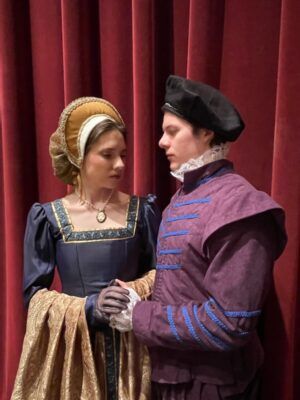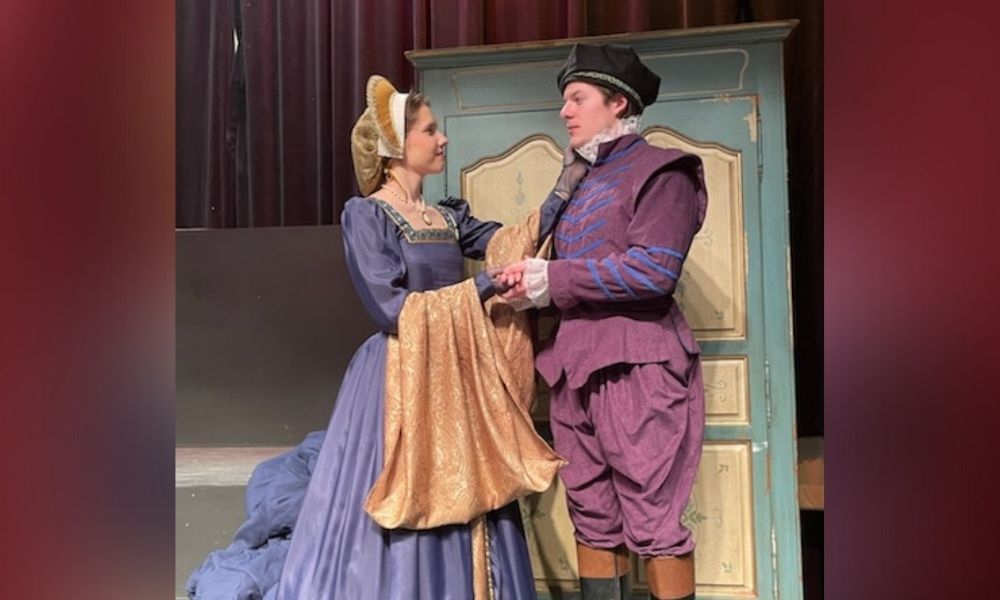Coming to the Newman University stage March 3-6, “Mary, Queen of Scots” — an adaptation of Friedrich Schiller’s “Mary Stuart” — brings to life the political and spiritual duel between Queen Mary and Queen Elizabeth.
From debates and pleas to sword fights and decrees, the play contains all the power and drama of an average Elizabethan play. Schiller’s commentary on gender, age, ambition and faith continues to stand as timeless discussions and anyone who attends is sure to be captured by the thoughts and emotions of this tragedy.
Watch the historical battle unfold with “Mary, Queen of Scots” with showtimes at 7:30 p.m. March 3-5 and 2 p.m. March 6 in the Performance Hall, located in the De Mattias Fine Arts Building.
Admission is $15 for the general public, $10 for faculty, staff, senior and military, $5 for students and free for Newman students with I.D. Guests can buy tickets online or at the door to reserve a seat.
The curtains open
Mark Mannette, the director of theater and chair of arts and humanities, explained some of the joys of putting on such an intense production.

“One of the joys,” Mannette said, “is an opportunity to bring history to life and share some stories of actual people with the public. Clearly, Queen Elizabeth is pretty well known, and people have heard of Queen Mary as well. Any chance to bring stories like this to the public is a joy.”
Equally, there are challenges of putting on works of Schiller, Shakespeare and others, as contemporary audiences are frequently intimidated by or disinterested in what appear to be works of antiquity. Mannette, however, argues that the universality of these pieces has paved the way for their continuous popularity.
“Part of the challenge in bringing history to life is that people wonder whether it’s relevant,” he said. “We have to make this story as compelling and engaging as possible. One of the great things about today’s world is if you go to a streaming service, you can see lots of history being brought to life. Hopefully, as people are excited by these accounts of history, they’ll be compelled to see a live version of it.”
Within the play, the characters are fighting and embracing common human feelings and themes, Mannette explained.
“One of the things I love about this play is you see a historical example of women in power. You have two strong women who are cousins, and they have both become queens, which was unusual at the time, as typically in this period, men were in power. But here, it’s the women who are in power.”

He compared this to the progression of modern society, as humanity continues to fight for equality of person and equity of power across the board.
“We’re moving away culturally from a patriarchal system, and moving into gender equality, racial equality and political equality,” Mannette said. “These two women were pioneers of their time, and they’re wanting to cooperate with each other, but given their political divide, they’re forced to fight against each other. People are polarized today, and they were polarized back then.”
This ongoing conflict between identities and equalities makes “Mary, Queen of Scots” a valuable piece of literature even 200 years past its premier, and 500 years past the historical event itself.
The spotlight shines
Senior Allison Williams, a double major of psychology and criminal justice, is moved by the concepts and contents of the story, and says she is honored to portray Queen Mary in the upcoming production. To her, the pacing of the play and elements of the stage are some of the most exciting aspects.
“I would say I’m most excited for the explosive tension in this show,” said Williams. “Everything builds until it reaches that breaking point. I’m excited for the beautiful costumes and to be on stage with my fellow actors again. I’m excited to bring Mary Stuart’s story to life once again because, whether you agree or disagree with this interpretation of history, it’s an important story that needs to be told.”
Of course, the grandeur of the script and spotlight comes with certain difficulties for the actresses and actors.
“Something I’ve found challenging in this piece is the depth of emotion within it,” Williams said. “It’s frustrating, it’s sad, it’s bitter. There are moments of elation and moments where each character hits rock bottom. It’s truly a test for the actors to play that range and not be consumed by it, especially the anger. I always have to step out after a rehearsal and remember that Mary is angry with Burleigh and Elizabeth but I’m not angry with Brenden and Rebekah.”

Williams appreciates the real-world connection she feels to her character, as she is finding parallels between Mary’s plight and her own identity and vocation.
“This play resonates with me as a criminal justice major,” she said. “The English laws presented in this play are, at times, expressly written to condemn Mary. She understands this, and knows she will never be able to win her life and her freedom as long as the pen writing the laws is against her. There are many groups throughout different countries in the world that this hopeless scenario applies to.”
The modern-day parallels extend, too, into the realm of gender and religion.
“As a woman, I see that Mary and Elizabeth are in similar positions. Both have power only as long as the men in their lives approve. In a time where having a queen ruling the land was still baffling, Mary and Elizabeth both had to play the game to show that they knew how to lead. In different circumstances, both had to proceed differently to prove themselves and those different routes were ultimately what pitted Mary and Elizabeth against each other.”
This play displays the tragedy of division, and how alliance and harmony would have led the queens down a very different path.
“They both had the same aim — to resolve the violence between Protestants and Catholics and find peace between Scotland and England. Had they worked together, this could have been achieved. But after the events of their lives, this would never have been an option.”
Tickets for “Mary, Queen of Scots” can be reserved online or at the door.

